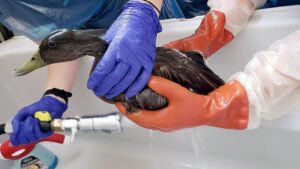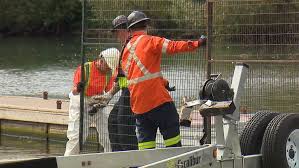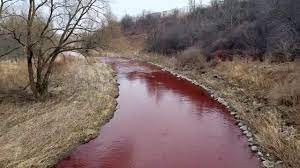
Etobicoke Creek is in bad shape with pollution similar to our other creeks as recent Rexdale fire that spilled chemicals in our watersheds leading to this duck being washed to remove chemicals.
The water quality and aquatic habitat conditions in the Etobicoke Creek is poor and contaminated with chlorides from road salt and phosphorous from fertilizers, according to a draft report by the Toronto and Region
Conservation Authority (TRCA).
The draft report states the contaminants include E. coli bacteria from sewage and animal wastes and copper and zinc from
industrial sources or roadways.
“Exceedances of chlorides and nitrates were also observed in groundwater,” the TRCA said in its Etobicoke Creek Watershed Plan that was the subject of two meetings last month.
The report follows outcry from residents over a heavy chemical fire retardant that covered, and is now mostly vacuumed, from watersheds as Humber River and Lake Ontario following a six-alarm factory fire in Rexdale.
The TRCA and GTA municipal governments are working to educate commercial and industrial partners to maintain chemical spills.
They are working “in collaboration with industrial landowners and the province to identify high-risk spill area and implement spill prevention an
contingency plans in accordance with provincial regulation,” the report states.
This will “educate commercial and industrial property owners on effective
maintenance of oil and grit separators, and other pollution control
infrastructure,” the authority wrote.
They are working “to identify sources of microplastics and emerging chemicals of concern, and to work with other levels of government to manage and remove these pollutants from the environment.”
The report said Etobicoke Creek’s “aquatic habitat conditions are poor, and the watershed has a high amount of runoff and in-stream barriers.”
The creek is second annually to the Don River in runoff in all
TRCA watersheds.
“The average habitat rating for fish is ‘fair’ and for benthic
communities is ‘poor,” they said.
Benthic communities are composed of macroinvertebrates, such
as annelids, mollusks, and crustaceans, which inhabit the bottom of estuaries and play a vital role in maintaining sediment
and water quality.
“With increasing urbanization, more sensitive fish species will be replaced
with species more tolerant of disturbance, and benthic communities will shift towards more pollution tolerant species.” the report warned.

